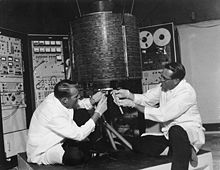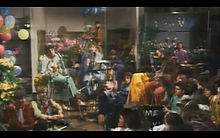- Our World (TV special)
-
For the American series of the same name, see Our World (TV series).
Our World Genre Satellite TV Special Created by Aubrey Singer Country of origin Various Language(s) Various Production Location(s) Various Running time 2.5 Hours[1] Broadcast Original channel Various Picture format B/W 4:3 SD Original airing 25 June 1967 Our World was the first live, international, satellite television production, which was broadcast on 25 June 1967. Creative artists, including opera singer Maria Callas, The Beatles and painter Pablo Picasso, representing nineteen different nations were invited to perform or appear in separate segments featuring their respective countries. The two-and-half-hour event had the largest television audience ever up to that date: an estimated 400 million people around the globe watched the broadcast.[2] Today, it is most famous for the segment from the United Kingdom starring The Beatles. They sang their specially composed song "All You Need Is Love" to close the broadcast.
Contents
Planning
 The Intelsat I nicknamed "Early Bird", one of the satellites used
The Intelsat I nicknamed "Early Bird", one of the satellites used
The project was conceived by BBC producer Aubrey Singer. It was transferred to the European Broadcasting Union, but the master control room for the broadcast was still at the BBC in London. The satellites used were Intelsat I (Early Bird), Intelsat II and ATS-1.[3]
It took ten months to bring everything together. One hitch was the sudden pull-out of the Eastern bloc countries headed by the Soviet Union in the week leading up to the broadcast. Apparently it was a protest at the Western nations' response to the Six Day War.[1]
The ground rules included that no politicians or heads of state could participate in the broadcast. In addition, everything had to be 'live', so no use of videotape or film was permitted. Ten thousand technicians, producers, and interpreters took part in this massive broadcast. Each country would have its own announcers, due to language issues, and interpreters would voice-over the original sound when not in a country's native language. In the end 14 countries participated in the production that was transmitted to 31 countries with an estimated audience between 400 to 700 million people.[1]
The broadcast
The opening credits were accompanied by the Our World theme sung in 22 different languages by the Vienna Boys Choir.[4][5]
Canada's CBC Television had Marshall McLuhan being interviewed in a Toronto television control room. At 7:17 pm GMT, the show switched to the United States' segment about the Glassboro, New Jersey, conference between American president Lyndon Johnson and Soviet premier Alexei Kosygin; since Our World insisted that no politicians be shown, only the house where the conference was being held was televised. National Educational Television's (NET) Dick McCutcheon ended up talking about the impact of the new television technology on a global scale.[1]
The show switched back to Canada at 7:18 pm GMT. Segments that were beamed worldwide were from a Ghost Lake, Alberta ranch, showing a rancher, and his cutting horse, cutting out a herd of cattle. The last Canadian segment was from Kitsilano Beach, located in Vancouver, British Columbia's Point Grey district at 7:19 pm GMT.[1]
At 7:20 pm GMT, the program shifted continents to Asia, with Tokyo, Japan being the next segment. It was 4:20 a.m. local time and NHK showed the construction of the Tokyo Subway system.[1]
The equator was crossed for the first time in the program when it switched to the Australian contribution, which was at 5:22 a.m. Australian Eastern Standard Time (AEST). This was the most technically complicated point in the broadcast, as both the Japanese and Australian satellite ground stations had to reverse their actions: Tokyo had to go from transmit mode to receive mode, while Melbourne had to switch from receive to transmit mode. The segment dealt with Trams leaving the Hanna Street Depot in Melbourne with Australian Broadcasting Commission's Brian King explaining that sunrise was many hours away as it was winter there.[1] A scientific segment, later on in the broadcast, was also included that dealt with the Parkes Observatory tracking a deep space object.[6]
The Beatles' sequence
The broadcast took place at the height of the Vietnam War, and the group wanted to use the opportunity to convey a positive message expressing a philosophy of love.[7] They gave a live performance, transmitted at 8:54 pm GMT, performing a new song, written primarily by John Lennon, entitled "All You Need Is Love", which was composed especially for the occasion.[7] The Beatles invited many of their friends to the event to create a festive atmosphere and to join in on the song's chorus. Among the friends were members of The Rolling Stones, Eric Clapton, Marianne Faithfull, Keith Moon and Graham Nash.[7] The performance was preceded by just a single rehearsal.[7][8]
Although the entire program was originally transmitted in black and white (and thus the videotape recording was also in black and white), for its usage in the 1995 TV special The Beatles Anthology, The Beatles' performance on the 1967 programme was colourized – using colour photographs taken at the event as a reference.[9] The sequence opens in its original monochromatic format and rapidly morphs into full colour conveying the brightly-coloured "flower power" and "psychedelic" style clothing worn by The Beatles and their guests that was popular in 1967 during what was subsequently dubbed the "Summer of Love".[9]References and notes
- ^ a b c d e f g Burke, Stanley (25 June 1967). "Our World – A Sunday in 1967" (in English). CBC Archives (Canadian Broadcasting Corporation). http://archives.cbc.ca/IDC-1-112-1311-7733/1960s/1967/clip2. Retrieved 4 June 2007.
- ^ Harrington, Richard (24 November 2002). "His Musical Notes Have Become TV Landmarks". Washington Post. pp. Y06. http://player.interactual.com/news/McCartney.htm. Retrieved 4 June 2007.
- ^ "The Whole World's Watching". Air and Space Magazine (Smithsonian Institution). 1996. http://www.airspacemag.com/. Retrieved 4 June 2006.
- ^ Flowers, Brian; European Broadcasting Union (4 July 2007). "The Technical History of Eurovision" (in English). European Broadcasting Union. http://tech.ebu.ch/webdav/site/tech/shared/techreview/trev_311-flowers_eurovision.pdf. Retrieved 28 November 2007.
- ^ "Our World: first ever live international TV production" (in English). EBU Viewpoint (European Broadcasting Union). 4 July 2007. http://www.ebu.ch/en/union/news/2007/tcm_6-52450.php. Retrieved 28 November 2007.
- ^ Rowsthorn, Peter; Peter Rowsthorn (4 May 2007). "Moment in Time Episode 12: First Satellite Broadcast" (in English). Can We Help (Australian Broadcasting Corporation). http://abc.net.au/tv/canwehelp/txt/s1914605.htm. Retrieved 4 June 2007.
- ^ a b c d Sheppard, John (3 June 1987), It was 20 Years Ago Today, http://www.imdb.com/title/tt0093285/, retrieved 4 June 2007 Granada TV documentary shows the Beatles' Our World broadcast segment.
- ^ Hastings, Chris (23 July 2007), "Beatles never told of protests at satellite show", The Daily Telegraph (London), http://www.telegraph.co.uk/news/main.jhtml?xml=/news/2007/07/22/nbeatles122.xml, retrieved 28 November 2007
- ^ a b Sella, Tom (1996). "Anthology Home Video". Beatles Reference Library. http://www.beatlesagain.com/breflib/anthvid.html. Retrieved 27 June 2010. "Laserdisc 7, Side 1, Chapter 1"
External links
- Our World at The Internet Movie Database
- Our World clip at CBC digital archives
Categories:- 1967 television specials
- International broadcasting
- The Beatles and television
Wikimedia Foundation. 2010.

